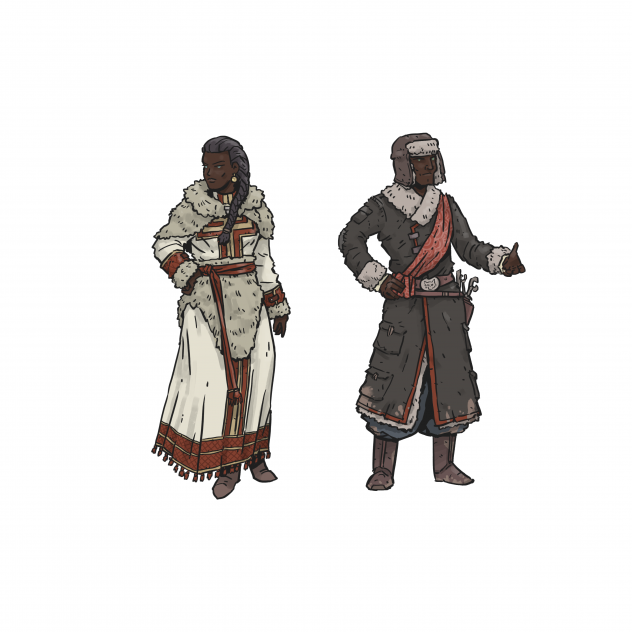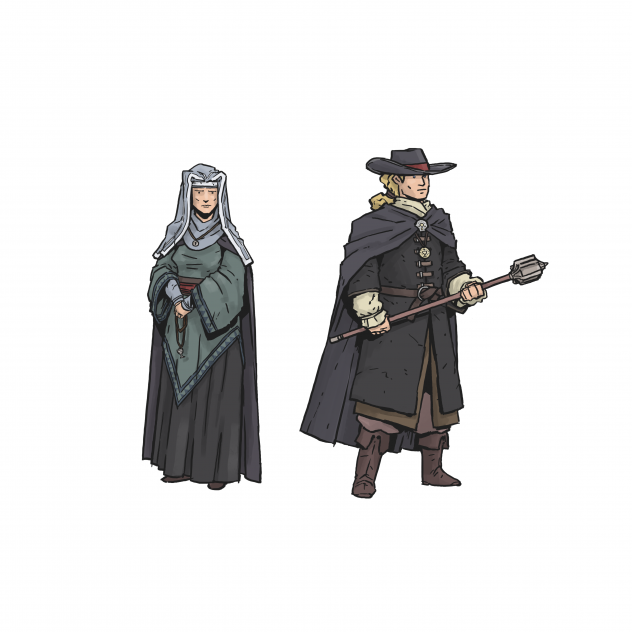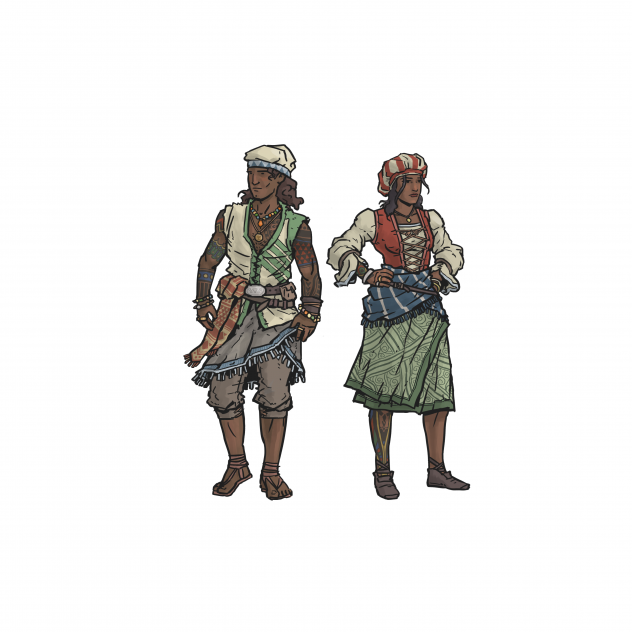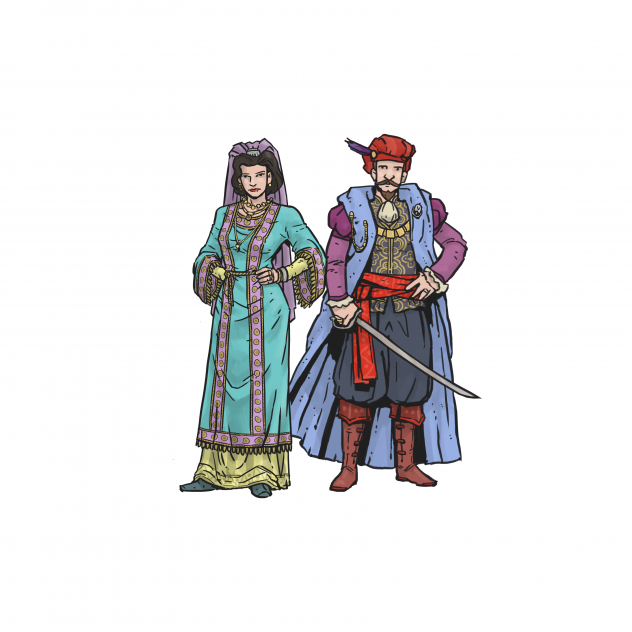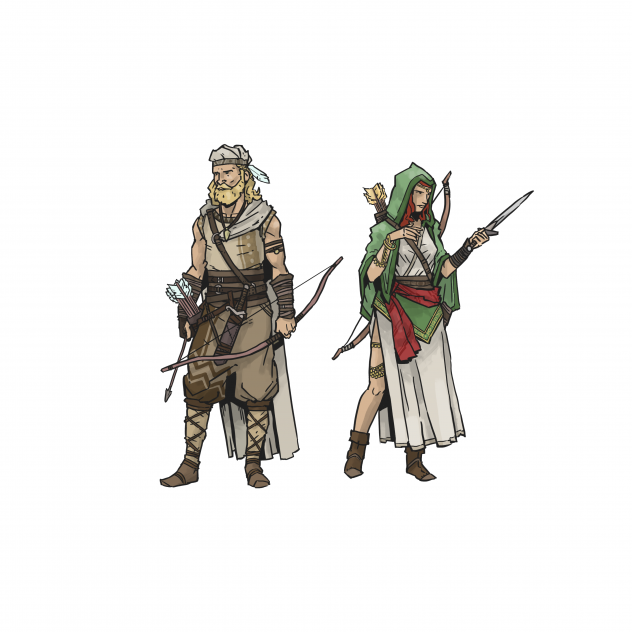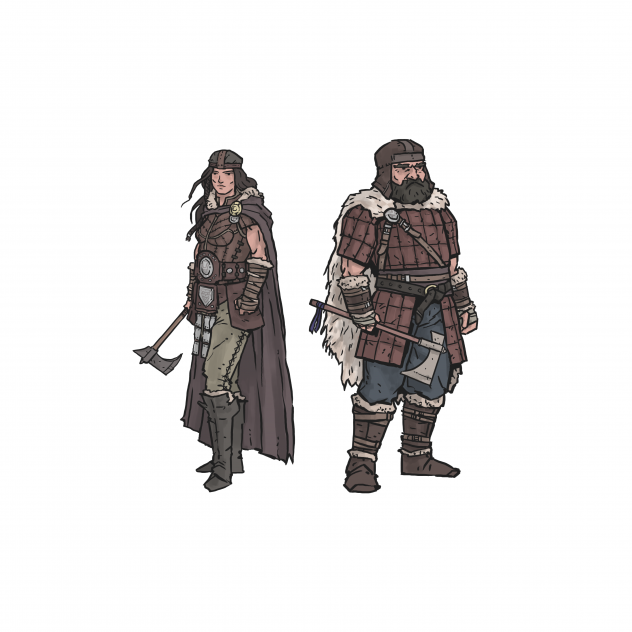FARIN
FEATURES
Hailing from the southern borders of the realm, Farin are known for their strict martial upbringing, their partiality to coffee, and cultural intolerance of alcohol. Their duchy, hot and dry in climate, borders the Daravi Sultanate, constantly pitting their population against Lithmore’s fiercest enemies.
As a people, Farin tend to be far taller than most others, and powerfully built with heavy slabs of muscle. While many Farin are dark complexioned, from warm gold to deep ebony in skintone, their appearance can vary wildly with any hint of foreign blood. Their natural hair tends to range from a darker brown to deep black, though a sun-bleached auburn is not peculiar, even on those black of skin. By and large, most Farins have naturally curly hair, though not all. Eyes are uniformly light brown to deep black. Sometimes, they are known to bleach or dye their hair with natural products such as lemon juice and henna.
Average Statistics:
Female: Height 1.85m (6’1″ ft), Weight 70 kg (158 lbs)
Male: Height 1.90m (6’3″ ft), Weight 92 kg (207 lbs)
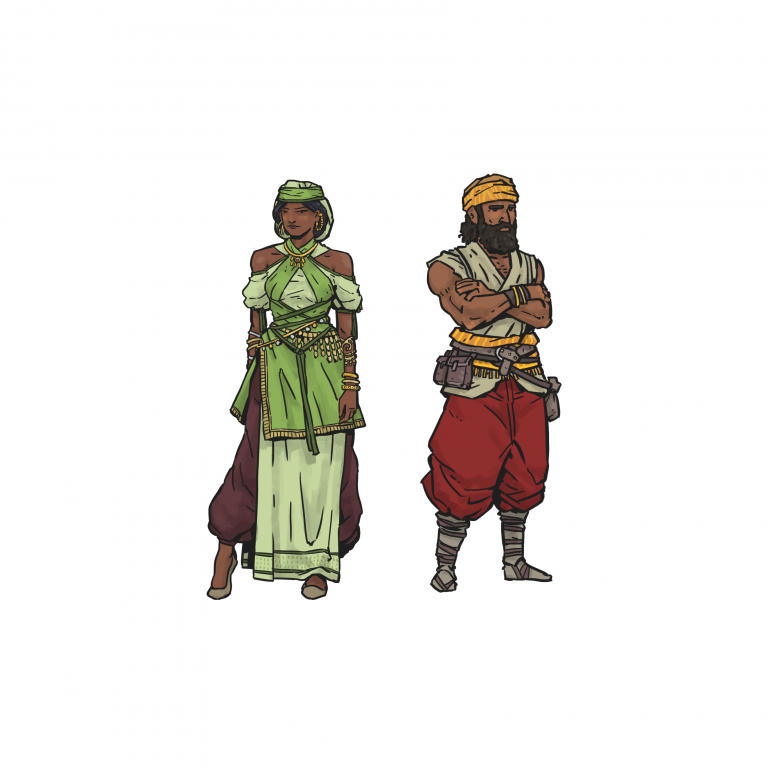
FAITH
Farin clergy tend to wear dull colors, often foregoing robes entirely to appear humble and devout before their congregation. Mass in Farin is a highly social event, with significant attention to giving voice to community concerns. The sermons are usually highly interactive, freely inviting parishioners to add comments or opinions so long as they do not derail or interrupt the priest. Communal wine is prohibited entirely, and instead the chalice is filled with spring water. In the Farin culture, Knights Lithmorran are accorded primacy, and sip from the chalice even before the officiating priest. They also, on a fairly regular basis, lead the community in brief sermons; and it is not altogether unusual for Knights to retire into the service of the priesthood, becoming lay advisers and consulars attached directly to a reigning bishop.
FASHION
Farin clothing is designed primarily with practicality in mind. The Kingdom’s hottest duchy requires the appropriate clothing for its climate, which can at times be “skimpy” compared to the costumes of the northern duchies. That is not to say, however, that Lithmorran modesty has not influenced the Farin people, especially those of the upper classes. Married women are especially expected to maintain a high level of decency and remain covered even in the most sweltering weather. Yet even when covered head-to-toe, the Farin’s clothing is always loose and light enough to allow for the free movement of air.
Basic Elements:
Status: Small details mark the differences in rank between people in Farin, making it more difficult for the casual observer to tell a noble from a commoner. Sumptuous fabrics like silk are difficult to obtain, especially in the far south, so even nobility are most frequently clad in common cotton or linen. The easiest way to determine who is of the highest rank is to look for the one who is dressed in the most colorful clothing. All Farin favor bright colors, but only the richest can afford multicolored patterns in their garments or elaborate embroidery. Stripes and flower patterns are especially popular. The poorest can be found wearing undyed linen, and little of it, at that. Gold thread and jewelry is reserved for the nobility and high-ranking Knights. Members of the clergy, by great contrast to the ceremonious Lithmorrans, are often the most humbly dressed of all, and even a bishop would avoid wearing gold.
Colors: Warm-colored dyes are the easiest to obtain in the south, so most Farin clothing is dark red, pink, orange, or yellow, with the occasional splash of green. Black, white, or undyed fabric is also popular, particularly with the lower classes.
Jewelry: All Farin people, even peasants, adorn themselves with jewelry. The lower classes tend to wear wooden beads, plain or painted in bright colors, on necklaces, bracelets, or in their hair. Higher classes prefer ivory or precious stones. The most common stones are malachite, hematite, obsidian, turquoise, lapis lazuli, and jasper. Malachite and hematite are said to protect from witchcraft. Also, all Farin have some type of ear piercing, and frequently pierce the nose or navel as well. Metal armbands are popular when sleeveless.
Men’s Clothing: The cut of Farin men’s clothing is nearly identical no matter what social class the wearer comes from. Shirts are high-collared, long, and nearly formless. Their long sleeves billow out to give plenty of space for air to circulate, and are sometimes gathered at the wrist. A decorative vest may be worn over the shirt. For formal occasions, a slightly more fitted, high-collared coat will replace the shirt altogether. In the cooler winter months, ponchos or shawls are worn over their attire. In the hottest months, men are excused from wearing shirts, even in public, although the practice of going topless is considered low class. On their legs, Farin men universally wear puffy pantaloons. These skirt-like trousers can be either knee- or ankle-length, but whatever the case, they are never tight like Lithmorran leggings. To protect them from the sun, Farin men wear a variety of headgear. Higher classes tend to prefer stylishly colorful turbans or bandannas, while workers choose the more practical wide-brimmed straw hat.
Women’s Clothing: Unmarried women, particularly those serving in the military, are socially permitted to dress themselves as men, or wear gowns and shirts which are sleeveless. Traditional Farin women’s clothing, being considerably more cumbersome than men’s clothing, is usually limited to wear by married women or women who are most interested in displaying their femininity, such as those seeking to soon be married. Many modern Farin women do not even wear gowns until the day of their En Passant. The proper woman wears a billowing, ankle-length, shapeless gown with a high collar and wide sleeves. In cooler months or on formal occasions, the gown is accompanied by layers of decorative shawls drooped over the shoulders. To complete this feminine outfit, a veil is worn over the hair. The veils can vary greatly in length, thickness, and style. The most modest woman would wear a veil which reaches her ankles and covers her entire face save her eyes, but this is hardly necessary by most standards.
TRADE
The Farin duchy is not only known for the excellent soldiers it produces, but also for its unique exports that are impossible to find in any other place in the Kingdom. Because Farin is a mostly desert environment, sand is in abundance and, as a result, glass is a major product. Glassblowers are some of the wealthiest artisans in the duchy and new varieties of colored glass are being developed every year, supplying churches around the Kingdom with their brilliant stained glass windows.
The Tarn Mountains in Farin are a large source of some of the Kingdom’s finest gems. Diamond, turquoise, opal, obsidian, jasper, garnet, and lapis are a few of the most important precious stones found in their mines.
Farin’s most important crops include sugarcane, coffee beans, bay laurel, mandrake, cumin, cotton, curry leaves, vanilla, coconuts, oregano, chili peppers, saffron, cloves, and myrrh.
Farin also supplies the Kingdom’s wealthy with exotic pets such as monkeys, parrots, tigers, lions, elephants, giraffes, and even rhinoceroses. The strange animals found in traveling Charali circuses were most likely purchased or stolen from Farin.
Although in slight decline since the shaky peace at the border, the slave trade of Farin is still strong. The wealthy of the Kingdom look to Farin for its slave workers, and Farin delivers with captured Daravi, kidnapped Charali, and even Farin who have been convicted of serious crimes which did not warrant the death penalty (such as failing to pay taxes or repay debts). The children of Farin slaves are born free, however, but it is not so for the children of Daravi or Charali slaves. Therefore, Farin slaves tend to remain in Farin, often working for the people they are indebted to, while foreign slave owners prefer to purchase Daravi or Charali, knowing that they can then breed more slaves. Slave trade is a dangerous but lucrative business, and a slave trader will usually not mention their business while traveling, for they are often met with distrust. While the kidnapping of Charali is not exactly smiled upon, there is no law which attempts to stop it.
FOOD
Farin cuisine is known for its intense flavors, colorful decoration, and the great variety of spices used. Maize is a staple of the diet, being cheap and easy to produce even in dry climates. It is used in making pastes, broths, and tortilla which, along with pita bread, is used as a wrap. Most Farin meals are eaten as wraps. Chicken, beef, and lamb are the most common meats, but beans make an excellent substitute. Tomatoes, lettuce, onions, squash, chili peppers, avocados, sweet potatoes, papayas, pineapples, bananas, radishes, and cheese also find their way into wraps. Spicy sauces, sour cream, and guacamole further serve to enhance the already strong flavors. Brown rice is a popular side dish.
Alcohol is considered immoral and is thus uncommon in Farin and never served with a meal. Instead, Farin drink coffee (hot or cold), chocolate, milk, pineapple juice, or coconut milk. Sweet corn cake, flan, marzipan, and rice pudding with cinnamon are favorite desserts, although fresh fruit is preferable when possible. The most popular dessert fruits are watermelons, cantaloupes, pineapples, bananas, and grapes (including raisins). Sugarcane is also often chewed raw as a snack.
CUSTOMS
Engagement: The Farin engagement process is regarded as a business transaction between the two families involved, and the terms of the marriage often take months to negotiate. The intended husband is expected to present the bride’s family with a gift, usually gold or treasures, as a display of his ability to care for her and as a repayment for taking one of the family’s precious daughters. The daughter has no say in the decision; if her father agrees, she must marry the man or run away and risk being disowned. Numerous songs tell of pretty peasant girls who save their families from destitution by marrying a wealthy Knight, or of wild-spirited girls who run away from a particularly cruel suitor.
Wedding Ceremony: The Farin wedding ceremony is an ancient ritual that was adopted by Farin Davites, and therefore it is unique in comparison to the other marriage customs in the Kingdom. Unlike most masses, weddings are conducted outdoors, usually at the most lush garden that can be located in the area. The bride is traditionally dressed in blue (or at least some blue elements, if the dye for an entire outfit cannot be afforded) and the groom in pure white. The audience is separated into the two sections, one for the bride’s family and one for the groom’s, with a wide aisle in between. The groom waits by the altar with the presiding priest while the elder of the bride’s family walks her down the aisle, then hands her to the groom. They hold hands while they give their vows (usually written themselves), then the priest places one flower crown on the bride’s head and an identical one on the groom’s, murmuring a fertility blessing. Then the couple are paraded in a circle around the altar five times (some whisper that this is to represent the blessings from the ancient gods, but most simply explain it as “old tradition” connected to the joining of a couple for the creation of life) before they finally kiss and the ceremony is over. A public feast usually follows, then the couple departs for their new home at the groom’s family house. In North Farin, some couples exchange wedding rings at the same time that they are crowned with flowers, but this is adopted from the Lithmorran ceremony rather than tradition.
Dancing: Music and dancing are present at just about every public occasion in Farin. Unless one is missing a leg, one does not avoid dancing. It would result in public ridicule. Children learn to dance at a young age, if not from formal lessons then simply from attending festivals. Dancing is not considered “girly” unless that particular song is meant to be danced to only by women; even the gruffest soldier will get up and dance when the music is appropriate (to admit that he cannot dance would be embarrassing and emasculating). Farin dances are typically done in circles or spirals, with the lead of the line performing fancy moves like kicks or flips for a few moments before moving to the end of the line to allow the next lead to take his spot. Some male-only dances even involve the juggling or swinging of knives and swords. Outsiders have remarked on Farin dances, “It is amazing to witness, that people who have suffered so much over the centuries yet retain such a zest for life, such bursting joy.”
MORALS
Honor is by far the most important virtue in Farin society. It is what makes a person truly human. To put up a facade is to refute one’s own existence. A liar is only a shadow of a man, someone who does not exist in reality. If one is revealed as a liar, the social ramifications are numerous. A single lie could cost someone a friendship, for if they have lied once, how can one ever know if they’ve lied numerous times? Infidelity, disloyalty, and lying are the greatest crimes after witchcraft and heresy, and in some fanatical places those crimes are punishable by branding or death.
Farin people also consider drinking alcohol immoral, for it dulls the mind and often leads to sinful acts. Cafes take the place of taverns as a town’s social gathering places. The Farin do, however, love a good party. Festivals are held often, even during times of war, to increase morale, and everyone is free to engage in boisterous dances with multiple partners. Smoking tabac is also a favorite means of relaxation for Farin, especially men.
Religion is important to Farin life. Mass in Farin is a highly social event, with significant attention to giving voice to community concerns. The sermons are usually highly interactive, freely inviting parishioners to add comments or opinions so long as they do not derail or interrupt the priest. In the Farin culture, Knights are accorded primacy, and sip from the chalice even before the officiating priest. They also, on a fairly regular basis, lead the community in brief sermons; and it is not altogether unusual for Knights to retire into the service of the priesthood, becoming lay advisers and consulars attached directly to a reigning bishop. Farin clergy tend to wear dull colors, often foregoing robes entirely to appear humble and devout before their congregation.
PERSPECTIVES
Lithmorran:
Sometimes they need reminders about their place as the Lord’s chosen.
Vandagan:
Honor is upholding virtues and vows in actions not just practiced words.
Vavardi:
Vanity and arrogance are not virtues in the eyes of the Lord.
Charali:
A faithless people, their words are not to be trusted.
Hill Folk:
A simple people in need of guidance, but their dedication to the faith should be lauded.
Tubori:
The song says, “Tubori have the sweetest wine” but is missing the lines,
“Their paradise, the Lord denies / All because of that evil vine.”
Daravi:
A blight on the bloodline of man, might one day the Consolidation come to them as well.
Order:
Like the Holy Springs, the Holy Order helps to remind us of the purity required to be free of sin.
Reeves:
Meting out judgement with truth is an honorable calling.
Troubadours:
There can be no fete without music and dancing. A Fariner’s duty is heavy, and without bards it might be unbearable.
Brotherhood:
A life of lies begets what it deserves.
Merchants:
A masterful Merchant will see the Bazaar filled with wonders, but be mindful of the less honest ones.
Physicians:
Treat them with respect. You will owe one your life someday.
Council:
Our leaders should know and respect their duties to the people.
The Knights:
There is no higher calling than serving the Lord in the battle against evil.
